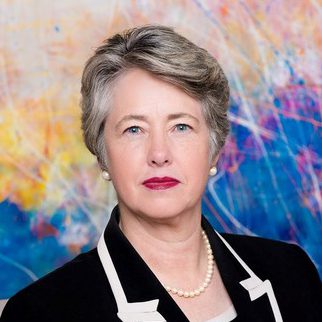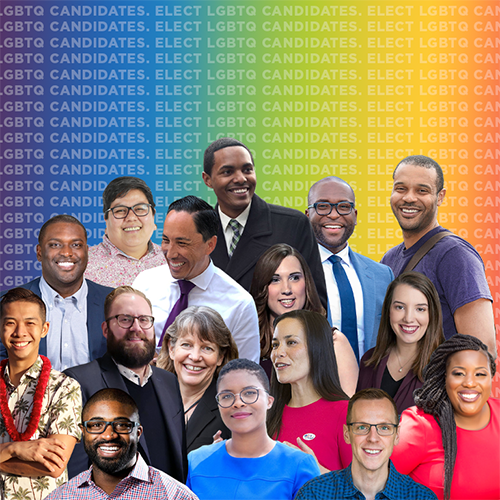
“LGBTQ Victory Fund is pleased to present you with our second annual Out on the Trail report – which analyzes the number and diversity of out LGBTQ candidates who ran for office in 2021. Many political organizations call 2021 an ‘off-year,’ but not us. More than 400 LGBTQ people ran for office – a historic number for an odd-numbered election year – and those who win can have a tremendous impact in their communities. LGBTQ candidates are growing in their diversity, with more Black, trans, non-binary, queer and bisexual candidates than in any other odd-numbered election year. Please enjoy exploring the amazing candidates looking to move equality forward. Together, we can build LGBTQ political power nationwide.”
– Mayor Annise Parker, President & CEO of LGBTQ Victory Fund
October 2021
UPDATE: November 2021
The 2021 Out on the Trail report was released in October 2021. In the lead up to and following the November 2021 election, more LGBTQ candidates were identified. For the final number and demographics of LGBTQ candidates in 2021, view our post-election media release.
A Note on Methodology: The following data represents the known out LGBTQ candidates who ran in 2021 and is the most comprehensive database of U.S. LGBTQ candidates in existence. Yet with nearly 520,000 elected positions in the U.S., it is assumed some LGBTQ candidates are not accounted for. Victory Fund identifies candidates through endorsement applications, extensive media monitoring, and assistance from dozens of state and local LGBTQ and political organizations.
A Note on Report Navigation: The graphs in this report are interactive both on desktop and mobile. To highlight a particular category and see the numerical values, select or deselect categories in the legend. The data for each graph can be downloaded by clicking on the icon on the bottom-left of each graph.
2021 Overview & Key Findings
At least 410 out LGBTQ people ran or are running for offices with elections in 2021, a 7.3 percent increase compared to the last odd-numbered election cycle in 2019, when 382 out candidates ran. Of the 410 candidates, 237 will be on the ballot in November, an 18.5 percent jump from 2019, when 200 out candidates were on the November ballot.
The findings compare data from 2019 with data from 2021 because both were “off-year” odd-numbered election cycles, a more relevant comparison point than 2020, which was a presidential year when significantly more positions were up for election.
Among the key findings:
- 36 percent of LGBTQ candidates who ran or are running in 2021 identify as people of color, making them significantly more racially and ethnically diverse than U.S. candidates overall,* and the most diverse group of LGBTQ candidates in history;
- Women of color remain severely underrepresented among LGBTQ candidates, making up just 10 percent of LGBTQ candidates and four percent of candidates overall, despite being 20 percent of the U.S. population.
- Black LGBTQ candidates grew significantly between 2019 and 2021, with 17.8 percent of LGBTQ candidates (73) in 2021 identifying as Black compared to just 12.3 percent of LGBTQ candidates (47) in 2019;
- Asian and Pacific Islander LGBTQ candidates more than doubled, from five in 2019 to 12 in 2021;
- Genderqueer and non-binary candidates more than tripled (from five in 2019 to 18 in 2021) and trans-identified candidates increased from 19 to 26 (representing 6.3 percent of LGBTQ candidates in 2021);
- Queer-identified candidates more than doubled, from 25 (6.5 percent) in 2019 to 62 (15.1 percent) in 2021, and bisexual candidates nearly doubled, from 24 (6.3 percent) to 42 (10.2 percent) in 2021;
- LGBTQ candidates ran or are running in 39 states – 81.9 percent for local positions;
- Of the 173 candidates who ran in 2021 races but are not on the November ballot, 42 already won their election, 103 lost and 28 dropped out; and
- Voters must elect 128 LGBTQ candidates on Election Day – for a total of 170 LGBTQ candidates elected throughout the 2021 cycle – to surpass the previous odd-numbered election year record set in 2019, when 169 LGBTQ candidates won.
or more LGBTQ people ran for office in 2021
increase in LGBTQ candidates between 2019 and 2021
or more LGBTQ candidates will be on the ballot in Nov. 2021
increase in LGBTQ candidates on the Nov. ballot between 2019 and 2021
LGBTQ candidates must win on Election Day to surpass the 169 who won throughout 2019
* The total 2018 candidate population (including heterosexual, cisgender and LGBTQ candidates) is estimated to be 10 percent people of color, as calculated in Reflective Democracy Campaign’s “The Electability Myth” report. 2018 is the last year for which this data is available.
Race & Ethnicity of LGBTQ Candidates in 2021
Thirty-six percent of LGBTQ candidates who ran or are running in 2021 identify as people of color, compared to 32 percent in 2019. In both years, LGBTQ candidates were significantly more racially and ethnically diverse than the general candidate population in the U.S., which shows approximately 10 percent of all candidates who run are people of color.*
Asian and Pacific Islander and Black LGBTQ candidates saw significant proportional increases in representation in 2021. Asian and Pacific Islander LGBTQ candidates increased from five in 2019 to 12 in 2021, and Black LGBTQ candidates increased from 47 to 73. Nearly 18 percent of all LGBTQ candidates in 2021 were Black, compared to just over 12 percent in 2019.
of LGBTQ candidates were people of color in 2021
of LGBTQ candidates in 2021 were Black
of LGBTQ candidates in 2021 were Latinx
of LGBTQ candidates in 2021 were Asian & Pacific Islander
* The racial diversity of the total 2018 candidate population (including heterosexual, cisgender and LGBTQ candidates) is calculated in Reflective Democracy Campaign’s “The Electability Myth” report. 2018 is the last year for which this data is available.
** Of the 410 LGBTQ candidates identified in 2021, Victory Fund was able to determine the exact race and/or ethnicity for 408 of them. In 2020, it was 780 of 1006; in 2019, 341 of 382; and in 2018, 588 of 716. All graphs and percentages are based on candidates for whom this information was known.
Sexual Orientation of LGBTQ Candidates in 2021
Bisexual, queer and heterosexual* candidates saw the greatest proportional growth among sexual orientation groups, with queer-identified candidates surpassing lesbians to become the second largest sexual orientation group. For the first time, the number of gay men and lesbians running in an odd-numbered election year shrank, despite the increase in LGBTQ people running overall.
increase in queer candidates (from 25 in 2019 to 62 in 2021)
increase in bisexual candidates (from 24 in 2019 to 42 in 2021)
decrease in gay men candidates (from 205 in 2019 to 190 in 2021)
decrease in lesbian candidates (from 74 in 2019 to 60 in 2021)
* All 2021 LGBTQ candidates who identify as heterosexual also identify with a non-cisgender gender identity, such as transgender or non-binary.
** Of the 410 LGBTQ candidates identified in 2021, Victory Fund was able to determine the exact sexual orientation for 380 of them. In 2020, it was 764 of 1006; in 2019, 351 of 382; and in 2018, 602 of 716. All graphs and percentages are based on candidates for whom this information was known.
Sex and Gender of LGBTQ Candidates in 2021
While the majority of LGBTQ candidates remain cisgender men, between 2019 and 2021 their numbers grew at a significantly lower rate (5.4 percent) than candidates with other gender identities. Genderqueer/non-binary candidates grew by 260 percent — to 18 candidates in 2021 — and the number of trans men doubled from 2019 to 2021 (with six running in 2021). Twenty trans women ran in 2021, up from 16 in 2019 — a growth of 25 percent.
increase in cisgender men candidates (from 222 in 2019 to 234 in 2021)
increase in cisgender women candidates (from 103 in 2019 to 119 in 2021)
increase in genderqueer/non-binary candidates (from 5 in 2019 to 18 in 2021)
increase in trans men candidates (from 3 in 2019 to 6 in 2021)
* Of the 410 LGBTQ candidates identified in 2021, Victory Fund was able to determine the exact gender identity and expression for 407 of them. In 2020, it was 782 of 1006; in 2019, 359 of 382; and in 2018, 637 of 716. All graphs and percentages are based on candidates for whom this information was found.
LGBTQ Candidates by State & Position in 2021
LGBTQ candidates ran in 39 states in 2021, with the following states having no known LGBTQ candidates who ran: Arkansas, Hawaii, Indiana, Kentucky, Mississippi, Nevada, North Dakota, South Carolina, South Dakota, West Virginia and Wyoming. Some of these state have few, or no, elections in odd-numbered years.
Of the 410 candidates who ran, 336 (81.9 percent) ran for local positions (excluding mayors), 39 (9.5 percent) for mayor, 19 (4.6 percent) for state legislature, eight (1.9 percent) for judicial positions, five (1.2 percent) for statewide races, and three (0.7 percent) for federal special elections.
2021 Victory Fund Endorsed Candidates
LGBTQ Victory Fund endorsed 178 out LGBTQ candidates in 2021 and 135 will appear on the general election ballot in November.
Key Takeaways

Victory Fund continues to make diversifying our pipeline of LGBTQ candidates a priority. LGBTQ people of color – and in particular LGBTQ women of color – face many barriers to running for office including sexism, racism, homophobia and transphobia. Transgender people – and in particular transgender men – face similar barriers that often prevent them from running.
Victory Fund is actively working to recruit and support candidates of color and trans candidates and is encouraging our donor network to invest in their campaigns. We also aim to amplify the voices of diverse candidates through our Spotlight Candidate program, which provides additional candidate services and fundraising opportunities to these candidates.
Victory Institute, our non-profit 501c3 organization, is working to diversify the pipeline of future candidates by ensuring our signature Candidate & Campaign Trainings are as diverse as our community. Our Victory Empowerment Fellowship, which provides candidates of color and/or trans candidates with campaign training, mentorship opportunities and access to our national network of LGBTQ elected officials, also aims to diversify LGBTQ candidates.

Support LGBTQ Victory Fund
LGBTQ Victory Fund works to achieve and sustain equality by increasing the number of openly LGBTQ elected officials at all levels of government while ensuring they reflect the diversity of those they serve.